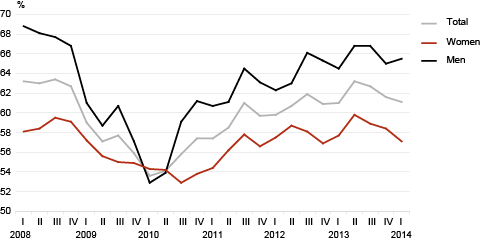Unemployment and employment both decreased in the 1st quarter
According to the data of the Labour Force Survey, employment decreased in the 1st quarter due to diminishing working-age population (this decrease is connected to negative net migration) and the increasing number of economically inactive persons. The estimated number of employed persons was 606,000, which was lower compared to both the previous quarter and the same quarter of the previous year. The employment rate of the population aged 15–74 was 61.1% in the 1st quarter, which is 0.5 percentage points lower than in the 4th quarter of 2013 (61.6%) and only 0.1 percentage points higher than in the 1st quarter of 2013 (61.0%). Employment decreased the most among older workers – the number of the employed aged 50–74 decreased by 10,000 compared to the same period of 2013. Employment of women decreased, while employment of men increased slightly.
The decline in employment was most of all influenced by a decrease in the number of persons employed in manufacturing, agriculture and forestry, and compared to the previous quarter also in construction. There was a slight increase in the number of persons employed in information and communication, professional, scientific and technical activities, human health and social work activities, and arts, entertainment and recreation.
According to the data of the Labour Force Survey, the estimated number of unemployed persons was 57,000 in the 1st quarter, which is 2,000 less than in the 4th quarter of 2013 and 11,000 less than in the 1st quarter of 2013. The unemployment rate was lower than in the 4th quarter and the 1st quarter of 2013 (when the unemployment rate was 8.7% and 10.0%, respectively). The decline in unemployment has slowed down in recent quarters.
Since mid-2011, unemployment has decreased mainly due to the decreasing number of the long-term unemployed (i.e. people who had been looking for a job for one year or longer),
but in the last two quarters the decline in long-term unemployment has stopped. The long-term unemployed numbered 25,000 in the 1st quarter (31,000 the year earlier) and the long-term unemployment rate was 3.7%. The short-term unemployed (i.e. people who had been looking for a job for under a year) were predominant among the unemployed, numbering 32,000 in the 1st quarter. Although the short-term unemployed numbered 5,000 less compared to the 1st quarter of 2013, their number has stayed quite stable since 2012.
In the 1st quarter, the number of unemployed men remained the same as in the 4th quarter of 2013 and the number of unemployed women decreased by 2,000. The unemployment rate of men was 9.4% and that of women was 7.7%.
In the 1st quarter, youth unemployment decreased – the youth unemployment rate (i.e. the share of unemployed persons aged 15–24 among the labour force of the same age) was 17.4%.
The young unemployed numbered 10,000 in total (compared to 14,000 the year earlier). As the youth unemployment rate is calculated as a share of those young people who are economically active (i.e. employed or unemployed), but most members of this age group are still studying, the share of the unemployed among all young people aged 15–24 was only 6.5%.
Economically inactive persons (students, retired persons, homemakers, discouraged persons, etc.) made up 33% (329,000) among persons aged 15–74 in the 1st quarter. This number increased compared to both the previous quarter and the 1st quarter of 2013. The growth was mainly due to an increase in the number of inactive middle-aged and elderly women. The main reasons for becoming economically inactive reflect the unstable situation in the labour market. Among inactive persons aged 15–74, the biggest increase occurred in the number of persons inactive due to health issues and the number of persons inactive due to the need to take care of family members; and there were more people who do not wish to work. There was also an increase in the number of discouraged persons, i.e. persons who have stopped seeking a job – they numbered 7,000 in the 1st quarter.
Employment rate by sex, 1st quarter 2008 – 1st quarter 2014
Unemployment rate is the share of the unemployed in the labour force (the sum of employed and unemployed persons). Long-term unemployment rate is the share of people who have been unemployed for a year or longer among the total labour force. Employment rate is the share of the employed in the working-age population (aged 15–74). The estimates are based on the data of the Labour Force Survey.
Statistics Estonia has been conducting the Labour Force Survey since 1995 and every quarter 5,000 persons participate in the survey. The Labour Force Survey is carried out by statistical organisations in all the European Union Member States on the basis of a harmonised methodology.
